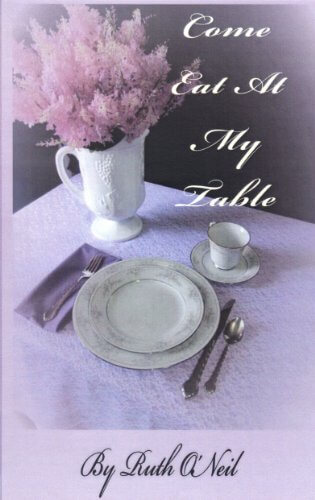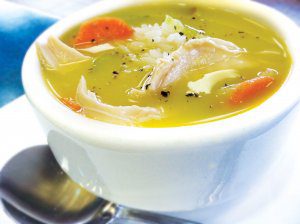This week’s guest blog post, The Love Language of Food, comes from my childhood friend and author, Ruth O’Neil. Ruth shares with us the ease of making and canning homemade soups. They not only taste delicious, they are healthier!
Read on for some healthy tips and two of her favorite recipes! Enjoy! And thank you Ruth!
The Love Language of Food
by Ruth O’Neil
Food is definitely my love language. I love food. I love eating. I remember events by what we had to eat. I love cooking for my friends and family, and I love spending time with my family and friends over a meal, lingering at the table after eating, just chatting and enjoying each other’s company. And although I’m not a health nut, I do know that we should all eat foods in moderation. I also know that many store-bought, prepared foods are not all they claim to be. They might say “fat free” yet contain enough salt to harden the arteries just thinking about it.
Sodium
Most diets need a sodium intake of 1500 to 2300 milligrams, depending on health and age. Canned soups can be some of the worst culprits of added sodium, containing as much as 890 milligrams of sodium per serving. When you add that to the rest of the salt in your food each day, it won’t take long to reach even the high end of the daily recommended allowance. And, let’s face it, most of us eat more than the packaging gives us nutrition information for. Who wants to eat a half cup of soup?
BPA
There is also some concern in recent studies about the can itself. BPA, or bisphenol A, is a synthetic estrogen found in the epoxy coatings of food cans and has been linked to many health problems, namely cancer and hormonal issues. Visit the The Environmental Working Group website for a list of companies that don’t use BPA coating.
Fat Content
You also want to check the fat content in canned soups. Some of them are quite high. Ideally, you shouldn’t have more than 3 grams of fat per serving. Obviously cream soups are going to have a higher fat content than a vegetable soup, but you can still keep it under control. Some fattier soups, such as potato soup, are a wonderful, stick-to-your-ribs kind of soup on cold winter days, but they too, should be eaten moderately.
Cozying up with Homemade Soup
With the winter months ahead, I am already looking forward to cozying up with bowls of hot, homemade soup and stews. And they can be healthy too, especially if you prepare them yourself instead of opening a can. Soups are one of those foods you can allow to simmer all day, allowing the enticing aroma to reach all corners of your home.
When you make your own soups, none of the issues above will be a problem. You can bump up the protein and fiber content by adding lean chicken or turkey, beans, lentils, or split peas. Those ingredients also add to the stick-to-your-ribs factor.
 Making and Canning Your Own Soup
Making and Canning Your Own Soup
I have started making and canning my own soups, for the convenience and for the health issues. It might take me one whole day, but at the end of that day, I have enough soup to last me the winter. Here are a couple of my favorite recipes that I want to share with you. These will be included in the COME EAT AT MY TABLE companion cookbook, IN KARIN’S KITCHEN, coming out in 2017.
(Keep in mind that if you want to can your own homemade soups, you will need a pressure canner, especially if you want to add meat.)
Beef Stew
4 to 5 pounds of lean stew beef, cut into bite-size pieces
8 cups carrots, peeled and sliced
3 cups of corn
3 cups celery, sliced
3 cups onions, chopped
12 cups potatoes, chopped
4 teaspoons of salt
1 teaspoon of pepper
2 tablespoons of Worchester sauce
2 tablespoons olive oil
10-12 cups beef stock
Put about 1 tablespoon of olive oil and heavy pan and heat on medium-high. Add meat in an even layer. Don’t overcrowd. Brown the meat on all sides. Brown in more than one batch if necessary.
Remove the meat from the pan and add 1 cup of water or beef broth. Scrape up any browned bits from the bottom of the pan.
Add the meat and vegetables to a large bowl as well as the salt, pepper, Worchester sauce, and the scrapings from the bottom of the pan. Mix well.
Ladle the mixture into quart jars, filling them about three-fourths of the way. Top off the jars with beef stock, leaving 1-inch of head space in the jar.
Wipe the rim of the jar with a paper towel dipped in vinegar to remove any traces of food or oil. Top with a band and a lid. Follow the directions for your particular pressure canner and process for 90 minutes.
The stew will be thin. When ready to eat, pour the contents of jar into a sauce pan. Make a slurry using 1 cup of water and 1-2 tablespoons flour or cornstarch. Slowly pour, while stirring, into the simmering beef and vegetable mixture. Allow to cook until thickened.
 Chicken Soup
Chicken Soup
4 pounds chicken breasts
3 cups onions, chopped
3 cups carrots, peeled and sliced
3 cups celery, sliced
2 teaspoons of salt
½ teaspoon of pepper
½ teaspoon poultry seasoning
Please chicken breasts in a Dutch oven and cover with 8 cups of water. Add salt, pepper, poultry seasoning and vegetables. Bring to a simmer over medium heat. Cover and simmer until chicken is cooked through about 15 minutes. Strain and save the chicken stock. Taste the broth and adjust the seasonings if necessary.
Remove the chicken, cut up into bite sized pieces. Add the chicken and vegetables to a large bowl and mix well.
Ladle the mixture into quart jars, filling them about three-fourths of the way. Top off the jars with chicken stock, leaving 1-inch of head space in the jar.
Wipe the rim of the jar with a paper towel dipped in vinegar to remove any traces of food or oil. Top with a band and a lid. Follow the directions for your particular pressure canner and process for 90 minutes.
DO NOT CAN WITH NOODLES. To make chicken noodle soup, empty the contents of one jar into a sauce pan and add more chicken stock (which you can also can yourself). Bring to a simmer and add 2 cups noodles. Stir frequently until noodles are cooked through.
About Ruth O’Neil
 Ruth is a freelance writer who loves to stir reader’s emotions.
Ruth is a freelance writer who loves to stir reader’s emotions.
“If I can make you laugh or cry while reading one of my stories I will consider myself successful.”
Favorite Books:
“There are too many books to choose a favorite!”
Websites: https://ruthoneil.weebly.com/ and https://www.ruths-real-life.blogspot.com/
Facebook: https://www.facebook.com/RuthONeilAuthor




